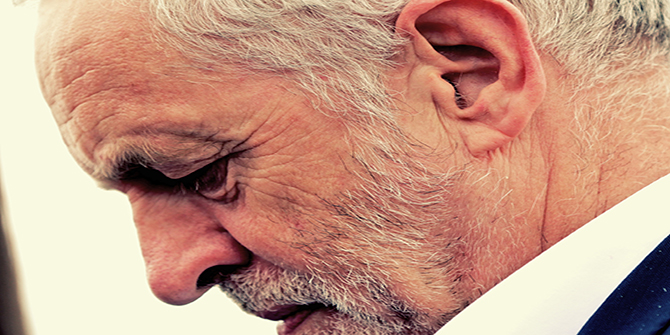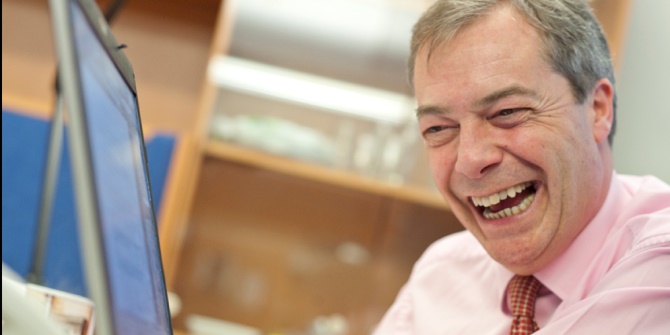 When witnesses appear before select committees, Hansard records their words, but not their expressions. Cheryl Schonhardt-Bailey analysed nonverbal behaviour in 12 economic policy committee hearings. She argues that gestures, expressions and tone may be pivotal in whether a policymaker’s arguments are accepted.
When witnesses appear before select committees, Hansard records their words, but not their expressions. Cheryl Schonhardt-Bailey analysed nonverbal behaviour in 12 economic policy committee hearings. She argues that gestures, expressions and tone may be pivotal in whether a policymaker’s arguments are accepted.
For one chapter of a forthcoming book, I adopted a two-part research design to gauge the role of nonverbal behaviour in parliamentary select committees. Three research assistants systematically coded nonverbal behaviour in 12 of the 37 hearings of the economic policy committees between 2010 and 2015.
1) Facial expressions, particularly in the form of anger and contempt, are far more prevalent in fiscal policy hearings, where backbench parliamentarians hold frontbench parliamentarians to account, than in monetary policy or financial stability hearings, where the witnesses being held to account are unelected policy experts.
2) Comparing committees across chambers, hearings in the Lords committee yield more reassuring facial expressions relative to hearings in the Commons committee, suggesting a more relaxed and less adversarial context in the former.
3) Central bank witnesses appearing before both the Commons and Lords committee tend towards expressions of appeasement, suggesting a willingness to defer to Parliament.
One particularly interesting aspect of this part of the research was the higher happiness/reassurance displayed by Treasury witnesses, relative to Bank of England experts. At first, this does not accord with the parallel findings of more anger and contempt by Treasury witnesses in these hearings. Figure 2 (below) shows photos of ex-chancellor George Osborne which were taken from the coded hearings. The contrast is between the top row and the bottom row (but ignoring his notable weight loss). The “smirk” in Osborne’s smile has been noted previously by journalists. and this element can be seen in the smiles on the first row. The second row smiles are quite different in being more genuine. More specifically, the bottom row smiles resemble the enjoyment smile (also known as the “Duchenne” smile, named after Duchenne de Boulogne), which accords with feelings of happiness or amusement, but may also be signalling cooperation. In the top row, Osborne’s teeth are less in evidence, and the muscles surrounding the eyes are not contracted, as one would expect from an enjoyment smile (Bucy, 2011). These “smiles of George Osborne” created something of a challenge for the three coders in capturing accurately the genuine and the more controlled expressions of Osborne, which in turn revealed a contrast in the coding by undergraduate RAs versus an older coder with some 20 years of experience.

The second stage of the nonverbal research design was an experiment conducted at the LSE Behavioural Research Lab. Eighty subjects, split into groups of 20, watched nine video clips, selected from the twelve parliamentary hearings previously coded in their entirety by the three RAs. A further 40 subjects served as a control group, in that they only listened to recordings of these same hearings. The participants were informed that the study sought to gauge deliberation in parliamentary hearings, but were not informed that the focus of the study was nonverbal communication. The lab experiment sought to uncover impressionistic evidence of the effects of nonverbal communication – that is, the extent to which nonverbal cues facilitate the persuasiveness of an argument or a person more generally, and by extension, the effect of these cues on the relevant deliberative process. The two groups – those who watched the videos versus those who only listened to the clips – allow us to control for the effects of facial expressions and gestures.
The results showed statistically significant differences between the viewing and the audio-only groups with respect to assessments of the witness’s competence. Moreover, once the videos are categorised by the type of nonverbal interaction between the questioner and witness (e.g., confrontational, conciliatory), statistically robust differences are found between four nonverbal interaction types. In parliamentary committee oversight hearings on financial stability, fiscal and monetary policy, while verbal deliberation is the focus, nonverbal communication may be pivotal in the acceptance or rejection of arguments proffered by policymakers.
This research is ongoing, and the results make a strong case for examining not just what is said in Parliament, but also how it is said. Sometimes, actions may indeed speak louder than words.
______
Note: This post was originally published on Democratic Audit. It is based on the author’s article in Politics and the Life Sciences and ‘Accountability, Oversight and Deliberation in Parliamentary Select Committees: How Politicians and Central Bankers Talk to One Another’. Research funding from the LSE Suntory and Toyota International Centre for Economics and Related Disciplines is gratefully acknowledged.
 Cheryl Schonhardt-Bailey is Professor in Political Science at the LSE. Her research interests are in political economy and quantitative textual analysis.
Cheryl Schonhardt-Bailey is Professor in Political Science at the LSE. Her research interests are in political economy and quantitative textual analysis.
References
Bucy, EP (2011). Nonverbal Communication, Emotion, and Political Evaluation. The Routledge Handbook of Emotions and Mass Media. K. Döveling, C. v. Scheve and E. A. Konijn. London, Routledge: 195-220.
Stewart, PA, et al. (2015). “Strengthening Bonds and Connecting with Followers: A Biobehavioral Inventory of Political Smiles.” Politics and the Life Sciences 34(1): 73-92.








As someone who as a civil servant appeared occasionally before Parliamentary committees, admittedly a very long time ago, I would suggest that the researchers bear in mind one difference between ministers and officials and other experts is that the former are very used to debating issues with their parliamentary colleagues while others who haven’t had that experience find it more of an ordeal and are naturally more respectful and cautious.